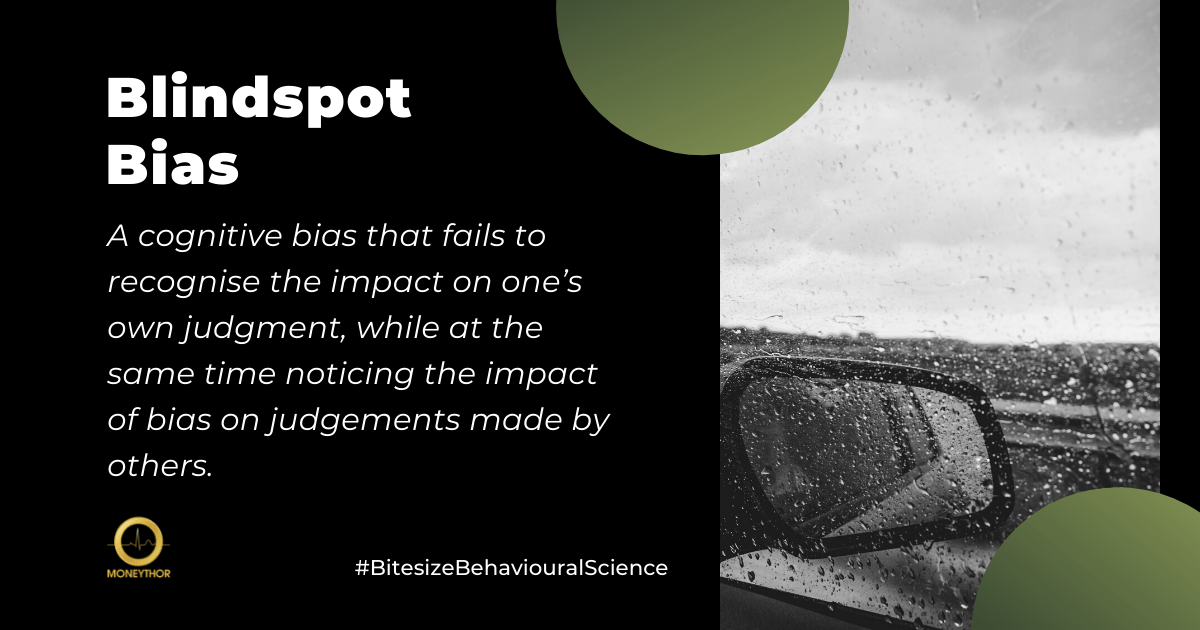What is a blind spot bias?
A blind spot bias is a cognitive bias that fails to recognise the impact on one’s own judgment, while at the same time noticing the impact of bias on judgements made by others.
People often consider their personal opinions to be staunchly objective and factual, as opposed to those who think or feel otherwise. As biases are unconscious, these self-observations are then treated as reliable benchmarks, rather than just personal opinions. A blind spot bias is formed now as a result of an introspective illusion, thus leading to people believing that they are more rational, and free of bias, unlike everyone else.
For example, someone purchases an extra box of cereal at the supermarket. Their blind spot bias might trick them into thinking that they love that particular brand of cereal, and therefore need more than one box. What they don’t realise is that their decision for the extra purchase was actually biased by a 2-for-1 discount, and the fancy packaging the cereal came in. Their blind spot bias prevented them from realising this, and they subconsciously bought a second box that they didn’t plan for initially.
Why does it happen?
Our senses are bombarded with an overwhelming amount of information all the time. It is impossible for our brain to process all the data that it receives. To help us get through life, our brain creates these shortcuts to understand and analyse the data that it receives.
We then develop these cognitive directives that we apply in our daily lives that help us form opinions, decisions and judgements. Our blind spot biases are developed the same way throughout our lives; through the lenses of our socio-economic background, culture, geography, education, childhood experiences and so forth.
Scopelliti et al (PDF) claim that there is a systematic tendency for people to believe that they are less biased than their peers, and this impartiality is known as a blind spot bias. “We developed a questionnaire to measure to what extent people think they are less biased than others on a variety of decision making biases and observed that surprisingly only one participant out of 661 reported to be more biased than the average person.”
People tend to notice cognitive blind spots and biases much more in others than in themselves. We generally rely on introspection when assessing our own biases, but we rely on observable behaviour when assessing biases in others. It is easy to understand that biases happen daily, but we are often time blinded to our own nurtured biases.
How can banks and financial services help their customers address and avoid blind spot bias?
PFM solutions
By providing customers with personal financial management (PFM) solutions, banks help them to be proactive about managing their blind spot biases. Tools like foresights about what expenditures a customer might have in the coming month will encourage them to scrutinise what they are spending their money on, and trigger them to make more deliberate financial decisions. Additionally, by creating messaging that helps customers acknowledge their inclinations towards a blind spot expenditure, customers are made to pause and rethink decisions, which helps them identify blind spot biases and potentially changing the way they react to the situation. For example, if a user sets a limit for how much money they can spend on taxis in a month, their money management tool will alert them when they are reaching the limit of their allocated budget. This helps them realise that they are about to reach their allocated spend, and may want to consider utilising public transportations more.
Financial wellbeing programmes
Our cognitive and blind spot biases can sometimes trick us into making financial decisions that are less than ideal. A good grasp of our financial outlook, coupled with financial wellbeing programs being offered by banks enable us to make better decisions. For example, if a customer wants to start investing, a financial wellbeing program can help by providing them with some investment training and tips to get started. This will be beneficial to help them understand what their appetite for risk should look like. Financial wellbeing programs can therefore help with rational decisioning, consistent analysis and planning for the future to ensure that the advantages and disadvantages of each choice is considered before making a decision and by mitigating the risk of suffering from their blind spot biases.
Conclusion
We are all prone to blind spots or cognitive biases. The more we feel that we are unbiased, the less clear we are of our own understanding. We will never be able to completely remove our blind spot biases, but acknowledging them is the first step to being able to operate outside their boundaries. Financial services can help consumers understand and evaluate their blind spot biases by highlighting when a biased decision has been made in their daily finances. This will help prevent blind spot biases from clouding judgements, thus allowing more rational financial decisions to be made.

